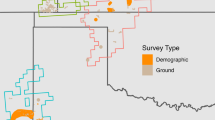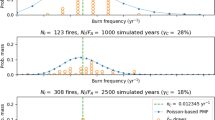Abstract
The method presented here assumes that a single observation can be identified with one of q functional models that compete with one another. The estimation method is based on the assumption that a theoretical quantity, called elementary split potential, can be assigned to each observation. Such quantity is referred to the theory of probability as well as to the theory of information. Parameters of the competitive functional models are estimated by maximizing the split potential globally over for the whole observation set. Additionally, such M split(q) estimates minimize the amount of information that could be provided by other estimates computed for the same observation set. The method is a certain kind of extension of the maximum likelihood method and if one considers the generalizations presented in the paper it can also be regarded as the development of M-estimation. Special attention is paid to the squared M split(q) estimation where the objective function is a squared one. If q = 1, then the squared M split(q) estimation is equivalent to the least squares method. The last part of the paper presents some numerical examples illustrating the properties of the squared M split(q) estimation as well as pointing at possible applications in geodesy and surveying.
Similar content being viewed by others
References
Andrews DF (1974) A robust method for multiple linear regression. Technometrics 16: 523–531
Chang XW, Guo Y (2005) Huber’s M-estimation in relative GPS positioning: computational aspects. J Geod 79: 351–362
Götzelmann M, Keller W, Reubelt T (2006) Gross error compensation for gravity field analysis based on kinematic orbit data. J Geod 80: 184–198
Hampel FR, Ronchetti EM, Rousseuw PJ, Stahel WA (1986) Robust statistics. The approach based on influence functions. Wiley, New York
Hodges JL Jr, Lehmann EL (1963) Estimates of location based on rank tests. Ann Math Stat 34: 598–611
Huang Y, Mertikas SP (1995) On the design of robust regression estimators. Manuscr Geod 20: 145–160
Huber PJ (1964) Robust estimation of location parameter. Ann Math Stat 43(4): 1041–1067
Huber PJ (1981) Robust statistics. Wiley, New York
Kadaj R (1988) Eine verallgemeinerte Klasse von Schätzverfahren mit praktischen Anwendungen. Zeitschrift für Vermessungswesen 113(4): 157–166
Kaufman L, Rousseeuw PJ (1990) Finding groups in data. Wiley, New York
Koch KR (1996) Robuste Parameterschätzung. Allg Vermess Nach 103(1): 1–18
Koch KR, Yang Y (1998) Robust Kalman filter for rank deficient observation models. J Geod 72: 436–441
Krarup T, Juhl J, Kubik K (1980) Gotterdammerung over least squares adjustment. Int Arch Photogramm 23 (B3) (Commiss III):369–378
Krarup T, Kubik K (1983) The Danish method; experience and philosophy. Deutsche Geodätische Kommission bei der Bayerischen Akademie der Wissenschaften, München, Reihe A, Heft Nr 7: 131–134
Kubáčkowá L, Kubáček L, Kukuča J (1987) Probability and statistics in geodesy and geophysics. Elsevier, Amsterdam
Kubáčkowá L, Kubáček L (1991) Optimum processing of measurements from a group of instruments affected by drift. Manuscr Geod 16: 148–154
Marshall J, Bethel J (1996) Basic concepts of L1 norm minimization for surveying applications. J Surv Eng 122(4): 168–180
Marshall J (2002) L1-norm pre analysis measures for geodetic networks. J Geod 76: 334–344
Rousseeuw PJ, Trauwaert E, Kaufman L (1995) Fuzzy claustering with high contrast. J Comput Appl Math 64: 81–90
Saleh J (2000) Robust estimation based on energy minimization principles. J Geod 74: 291–305
Schaffrin B (1985) On robust collocation. In: Sanso F (eds) Proc 1st Marussi Symp Math Geod, Milano, 1986, pp 343–361
Schaffrin B (1989) An alternative approach to robust collocation. Bull Géod 63: 395–404
Schaffrin B (1991) Generalized robustified Kalman filters for the integration of GPS and INS. Tech Rep 15, Geodetic Institute, Stuttgart University
Soto J, Aguiar MIV, Flores-Sintas A (2007) A fuzzy clustering application to precise orbit determination. J Comput Appl Math 204: 137–143
Teunissen PJG (1990) Nonlinear least squares. Manuscr Geod 15: 137–150
Wiśniewski Z (1985) The effect of the asymmetry of geodetic observation error distribution on the results of adjustment by the least squares method. Polish Acad Sci Geod Cartogr 34(11): 11–21
Wiśniewski Z (2009a) Estimation of parameters in a split functional model of geodetic observations (M split estimation). J Geod 83: 105–120
Wiśniewski Z (2009b) M split estimation. Part I: theoretical foundation. Polish Acad Sci Geod Cartogr 58: 3–21
Wiśniewski Z (2009c) M split estimation. Part II: squared M split estimation and numerical examples. Polish Acad Sci Geod Cartogr 58: 23–48
Xu P (1989) On robust estimation with correlated observations. Bull Géod 63: 237–252
Xu P (2002) A hybrid global optimization method: the one-dimensional case. J Comput Appl Math 147: 301–314
Xu P (2003) A hybrid global optimization method: the multi-dimensional case. J Comput Appl Math 155: 423–446
Xu P (2005) Sign-constrained robust least squares, subjective breakdown point and the effect of weights of observations on robustness. J Geod 79: 146–159
Yang Y (1991) Robust Bayesian estimation. Bull Géod 65: 145–150
Yang Y (1992) Robustifying collocation. Manuscr Geod 17: 21–28
Yang Y (1994) Robust estimation for dependent observations. Manuscr Geod 19: 10–17
Yang Y (1999) Robust estimation of geodetic datum transformation. J Geod 73: 268–274
Yang Y, Cheng MK, Shum CK, Tapley BD (1999) Robust estimation of systematic errors of satellite laser range. J Geod 73: 345–349
Yang Y, He H, Xu G (2001) Adaptively robust filtering for kinematic geodetic positioning. J Geod 75: 106–109
Yang Y, Song L, Xu T (2002) Robust estimation for correlated observations based on bifactor equivalent weights. J Geod 76: 353–358
Yang Y, Zhang S (2005) Adaptive fitting of systematic errors in navigation. J Geod 79: 43–49
Zhong D (1997) Robust estimation and optimal selection of polynomial parameters for the interpolation of GPS geoid heights. J Geod 71: 552–561
Author information
Authors and Affiliations
Corresponding author
Rights and permissions
About this article
Cite this article
Wiśniewski, Z. Msplit(q) estimation: estimation of parameters in a multi split functional model of geodetic observations. J Geod 84, 355–372 (2010). https://doi.org/10.1007/s00190-010-0373-7
Received:
Accepted:
Published:
Issue Date:
DOI: https://doi.org/10.1007/s00190-010-0373-7




